
Digest Standards Committee Hearing/Meeting Minutes
Download PDF file
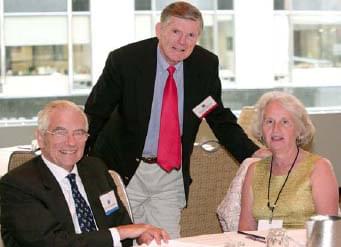
(Left) Dr. Jim Appleyard, Immediate Past President, World Medical Association,
(Middle) IAOMC President Bernard Ferguson, J.D.,
(Right) Dr. Lynn Eckhert, Director, Harvard Medical International.
Date:
August 12, 2005
Place:
Grand Hyatt Hotel, 109 East 42nd St. New York, NY
The meeting opened with President Bernie Ferguson, JD, welcoming all in
attendance including representatives of: Mission of Sudan to United Nations (UN); Permanent Bulgarian Mission to the UN; Dominican Medical Board; Medical Board of Trinidad and Tobago, Medical Council of Ireland, Steve Seeling, JD, Vice President, Education Commission Foreign Medical Graduates and Thomas Monahan, Executive Secretary, New York State Board of Medicine, appearing as an individual. Members of IAOMC committees and IAOMC Board Members were also present. He then introduced the Immediate Past President of the World Medical Association;
Dr. Jim Appleyard
The practice of medicine respects but is not contained by national barriers because suffering, disease and pestilence in one area of world impacts on others. And now the explosion of knowledge and web communication in medicine that is accelerated everybody into thinking globally
Historically, the European empire’s medical school grads had passport to ¼ of world. The flow of physicians was from the developed to the undeveloped colonies of the world.
Then the empires dissolved, the new nations trained their own citizen medical students. Licensure tests and processes are used for political purposes are adapted to meet the perceived protectionism that some required.
Today there is a reverse flow of medical practitioners from the undeveloped world to developed world. Recognition of overseas schools is an issue. There are difficulties with the World Health Organization list of medical schools.
What is accreditation? Some claim it is a process that will gradually drive up standards worldwide. Actually it is a process where you furnish credentials and you offer to sanction schools. You are building on World Federation of Medical Education’s minimum standards. Its purpose in adopting global standards was to safeguard the practice of medicine, including manpower utilization, and its increasing internationalization, by defining international standards for medical education. The accreditation aim is to stimulate medical schools to formulate their own plans for change and adopt quality improvement in association with these international regulations. Standards must provide a broad base education with those three pillars of education; skills, attitude, and behaviors. Put your ethical dimension as your top priority as a standard. A well- established part of the accreditation process is self-evaluation. I think your initiative to weight the standards is terribly important all Kassabaum’s articles come to that conclusion. There must be adequate resources for clinical instructions. The top standard is to encourage developing ethical principals caring for patients.
Now the fundamental requirements for an accreditation system are that it must be trustworthy; based on academic competence, efficiency, transparency and fairness. This is something that comes very clearly from reading the standards that you are developing, and I warmly commend that.
Think global standards but apply them and act locally. Problems will start when implementing global standards at local levels. Particularly true if the individual countries and the countries you represent are too small to do it themselves. That means small countries joining together with other countries.
The LCME accreditation did not consistently count for 45 percent of its standards. Meaning they probably didn’t think them very important relative to others. You already started on that journey to decide the weighting of the different standards.
I don’t think you should be ashamed at all of being for profit. Medicine has always worked within the marketplace. We had to cope with market. The original contract, of course, was between the patient and the physician and there had to be payment. increasingly the concept was the public sector, therefore, was the particular custodian of the medical conscious which all medical ethical principles.
Thank you.
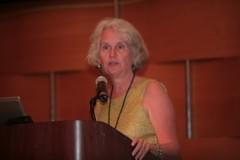
Dr. Eckhert described the guiding philosophy of Harvard Medical International: that every citizen of the world should have easy access to quality health care of a world standard. Since 1994, HMI is the nonprofit subsidiary of Harvard University and of the Medical School, providing an inner connecting board with Harvard Medical School and Harvard University. Comprising 40 programs in 30 countries, with a staff of about 55, HMI is committed to building an infrastructure related to either health care systems or medical education, and interested in long-term partnerships.
Dr. Eckhert presented an overview of the undergraduate, post graduate, and continuing education HM programs. Harvard Macy Programs are undergraduate medical education programs headed by Liz Armstrong with a team that supports hospitals and health care systems around the world. This team helps to improve policies in building new hospitals and helping determine what staff is needed, re-educating people, meeting the joint commission standards internationally, and providing education regarding the management of these systems. Many areas around the world have asked HMI to help develop basic research and ethics issues surrounding research, and how to set up animal systems which may or may not exist in medical schools.
Dr. Eckhert spoke of the Harvard name recognition worldwide and of LCME aspiring to a similar approach to standard development, and the current process for establishing and meeting criteria for attaining those high levels. She said, “as citizens need access to the highest quality health care systems, hospitals and physicians, it’s reasonable that medical students should have access to high quality medical schools.”
She described the HMI health system’s division group that works with hospitals. HMI does not accredit hospitals, but reviews them for the joint commission international preparation; helps them with education for quality improvement; helps them do a selfstudy, or does a study to determine which areas need improvement and how to move toward that improvement; an educational program is then designed for the school with
the hospital in mind, using a format not dissimilar to the LCME. “There’s no joint commission of international accreditation at this point; we’re not preparing people to have an LCME accreditation, but we are looking at international standards and doing a consultation saying we think you meet these kinds of standards, or we think that you have these areas to address for improvement.”
Alluding to discussions with the Joint Commission of Hospitals regarding the move from domestic accreditation to international accreditation, Dr. Eckhert said, “we share the same history.” She described the process of setting up a consulting system where they went to international hospitals, looked at the standards that they normally use for domestic hospitals, determined areas needing improvement, taking part in an education program to improve, and moving to the next level of actually having an accreditation process. The commonalities were extraordinary: people from Brazil and India and the Caribbean, the United States and the U.K., etc. agreed on most areas including patient flow issues, operating room standards, and emergency room functions. The biggest difference was in patient rights due to cultural differences; for example, counseling services for students. You have to take into account what some of the differences are. Zimbabwe had one of the most elaborate systems of community education; we discovered we could apply some of those lessons here. An interesting ongoing program is with one of the German schools. The medical students spend time at Harvard; they design a new program of education for their own school. A group of eight students from Germany put evidence-based medicine into their school curriculum.
Dr. Eckhert addressed the current LCME approach: First, defining the standards and agreeing on them. Next, the process of reviewing the schools, and how to accomplish self-assessment: what time does that take, how elaborate is it, who do you expect to do it at which schools, who’s going to analyze the schools, what are their credentials/ experience, and what do you expect of them? Dr. Eckhert assumed that during testing some schools would look better than others. If some things are added and/or some taken out, what are the results? And what are the actions? Do you give accreditation for a long period of time or a short probation? With many options it comes to redefining standards that the LCME is always adding or taking away on a regular basis. She described possibilities for innovation with normal things at the bottom — institution setting, educational programs, medical students, and faculty issues. At the top were questions asking what contribution the school is really making to either local, regional, national, international. What about the professionalism and social responsibility? What do the public and patients think of your product?
In an ideal medical school, Dr. Eckhert said there are core competencies that all graduates are expected to have. Those competencies are pretty much the same worldwide. There are certain skills and knowledge, basic science, clinical science that everyone needs to know, how we do it differs. Do evaluations include student performance, long-term experience, doctors who are extraordinary, those that don’t do so well? All schools: Canadian, American, U.K. should be doing those top items, but that’s more innovative, and may be where you want to go.
She described some of the Macy educational programs, believing that may be where any collaboration works best. Medical educational programs are created in institutions that meet global, regional, and local needs. The interest is in both education and how it interrelates with research and clinical, societal and academic missions, also cost effective processes that support these goals. Macy works on creating educational benchmarks to assure world-class quality and supports global networks; about 1,000 people have taken the Harvard/Macy Program. The approach is to look at the assessment of the health care needs and the stakeholders, assess strengths and weaknesses, do an analysis of medical schools; then establish priorities and time lines, looking at their goals, their mission statements, their vision of success, how are they are sustainable and the strategies involved.
Curriculum planning is the central area. If you decide what your curriculum is and put it in the center, all other things follow: kinds of faculty needed, kinds of students to recruit, the organizational structures. If you look at new medical schools around the world, you find that the organizational structures of the usual anatomy, physiology, biochemistry, etc. departments shift to fewer departments that are much more integrated, much more amalgamated. Standards setting accreditation procedures must allow for some of those changes. Facilities and technology are essential — particularly if it’s going to be a new school and you design your curriculum mostly around lectures, you’ll need great big lecture rooms. If curriculum has people moving away from lectures, but towards small groups, facility design must meet those needs.
Dr. Eckhert proposed evaluation strategies moving schools away from the multiple choice questions to using OSCIE’s, using simulated methods of assessment and teaching. Policies have students involved in both designing and evaluating their curriculum; an implementation plan for faculty prepared to make changes and to reach standards being set.
Dr. Eckhert concluded with an overall description of Harvard Macy Programs as a continuation of faculty development from information to transformation. Two major programs are 1) physician educator and 2) a leadership program focused on negotiating change and leading the new challenges in medical education. The benefits of attendance: to practice improved teaching skills, learn about measuring education outcomes, improve teaching skills, develop strategies for project development, develop new perspectives to assist in working with teams, and an opportunity to network with regional colleagues
The Meeting/hearing of the Standards Committee followed.
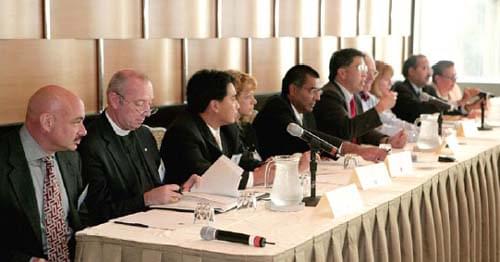
Present: (Left to right)
-
St George’s University Joe Feldman, MD
-
American University of the Caribbean, . Fr. Jeff Hamblin, MD
-
Our Lady of Fatima University, Vic Santos, MD
-
St. George’s University Mary Jo Demilia, MD
-
St. Matthew’s University Andy Vaithilingham, PhD
-
Saba University Joe Chu, MD Committee Chair
-
Saba University Pat Huff, MD
-
Universities of Lubin and Selesia Shokat Fattah, MD Hope Medical Institute
-
Ross University Nancy Perri, MD
Meeting Digest:
Joe Chu, M.D. committee chairman, opened the Standards Committee meeting. He said that everyone should have a copy of the proposed standards that were previously published on the Internet and distributed. The document in hand is a draft, with no final adoption expected during the meeting. He asked to have the committee people, as well as audience members, comment on concerns for consideration. The following issues
were discussed.
-
Weighting of each of the different standards. Should certain things that we think are more important be weighted more in terms of the evaluation and accreditation? Also perhaps develop a system to look at the way the standards are applied by different individuals to institutions. How we evaluate specific sites and how the faculty meet. Someone suggested a purpose of the weighting be some minimum set of standards that were absolute. There’s no possible way to achieve accreditation if certain items were not met; other items could perhaps not be met and yet represent some sort of partial accreditation.
. -
Distance education, from being a virtual campus to having recognized opportunities for student education. Distance learning involves teaching by blocks rather than by weeks, and is based on whenever the student wants to take the courses. Part of the discussion focused on the development and measure of a standard for competency. Whether it’s interactive or in CME you check, and it gives you a result. The ultimate question for accreditation is making sure that everyone can have access to a high standard or good level of care, and can competency be measured only in the sense of a number of weeks?
. -
American students who study at foreign medical schools, take licensing exams in the various boards, or practice in the various state boards. Vic Santos said initial focus should address minimum requirements of the state boards concerning their basic sciences. The students must have a specific number of required hours and then practice in the clinical area. Focus should be on the minimum requirements of the state boards. Forty-seven states require 128 weeks for licensure, but other countries may not require as many; to be global, we need to address them.
Most of our students are going to be taking the licensing exams in the United States; therefore, the various state boards would have their own requirements. It’s essential that we meet their minimum requirements. Whose responsibility is it to know what the requirements are in the country that you want to practice in? Is it up to the student to know what the requirement is and that School A meets the requirement, and School B does not, or is it the school’s responsibility to meet the requirements for every country? Should there be accreditation within this group that is categorized on different subsets of standards? Hypothetically we have standards for students who want to come back to the states. You’re accrediting medical schools, you have to have the flexibility and the standards so that it will allow people to go through the process and ultimately practice medicine wherever they want. When LCME goes out, they don’t worry about licensure, they worry about getting people through an acceptable program of medical education.
. -
Minimum number of weeks of education for curricula content: a breakdown of how detailed we want to be in terms of how many weeks of basic science, how many weeks of clinical experiences, and do we want to be even more proscriptive in what they should be? Joe Chu urged caution in terms of the numbers of weeks of education and the number of months of education as it relates to licensure requirements. Not just the United States but various countries around the world should be relatively general in the way that a standard is developed.
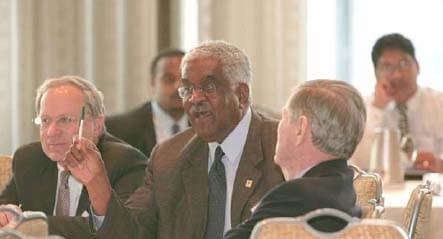
Dr. Dorrian Shillingford, Dominican Medical Board makes a point,
Steve Seiling JD, looks on.
An audience member mentioned page 5 under Mission and Objectives, Objective #2, General Design says, “the educational program must be at least 130 weeks in duration. That includes the basic science as well as the clinical training.” There’s some language that clarifies the MD degree because most countries around the world don’t confer the MD degree. You might want to call it the MD or equivalent or comparable degree for starters. That 130 weeks is directly or mostly from the LCME standards. In New York it’s 32 months which works out to be 4 academic years, close to 130 weeks. An audience member cited page 10-D of the document under Clinical Sciences Number 6 (VI) “Medical students shall participate in clinical courses and rotation not less than 72 weeks in duration.” So hypothetically, the 72 minus the 130, if you want to be minimal, is a number that is 58 weeks of basic science. The question is do we want to be so proscriptive the numbers mean you get very little basic science? Another member asked if that list of clinical rotations is core-mandated?
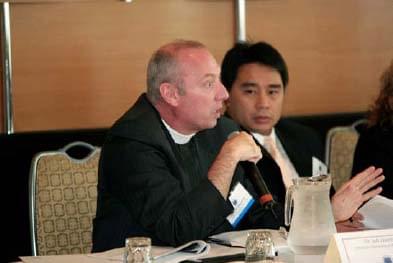
Standards Committee member Fr. Jeff Hamblin, MD,
AUC provides input as Vic Santos, MD Our Lady of Fatima, looks on.
There are some places where you may not find all fields included in core rotations. An example would be family practice. The concern is we should just mention about 72 weeks. European Union has a different set of standards that apply to certain schools in Polish settings, where they don’t require family medicine as part of core locations. If you become too specific, it may become an issue for many other medical schools. If you just say 72 weeks of clinical training that would be very helpful. You also may not want to designate the number of weeks in each course for clinical rotation because that will vary from country to country. The concern with this issue is some might hear that a clinical program should be at minimum 72 weeks in duration. Again we can address that as it
applies more globally.
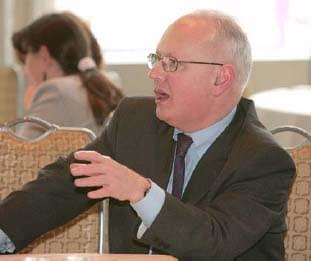
Dr. Muris Fitzgerald, Irish Medical Council, states his opinion
Muris Fitzgerald, Irish Medical Council, said in Europe there’s an ethical focus within a framework. He said standards that are prescriptive in terms of hours and subject matter as were out of touch with reality when compared with the diversity of educational activity that exists in reality out there.
Vic Santos agreed with diversity of curriculum across nations but said we should emphasize a basic core of knowledge and the basic subject matter within a different framework of time. He recommended not assessing a real figure but putting in a figure as a recommended number. He said the committee should say this is a recommended model time but it will have to boil down to the core teaching and core knowledge.
A proposal was made to not put in a number either for the number of weeks, for the entire curriculum, or the number of weeks of clinical. In parentheses insert the LCME standard is and give them an idea what the standard is. Let the site visit teams deal with the fact; if they’re so far outside of what we’re considering, they’re going to have to justify it somehow within their application. Rebuttal was if we don’t set a minimum number, then our standards lose credibility. Others agreed there should be a minimum number of weeks requirement, then leave it up to the institution. Two different systems were mentioned: medical education may be five to eight years, yet people come with a baccalaureate degree before they go to four years of medical school. If you’re going to use our model you need to have one standard for people who have a baccalaureate entering that kind of medical school and another standard for people who are coming out of high school.
The discussion looked at accrediting institutions that would provide medical knowledge throughout a world with diverse needs. Someone suggested a modular idea with different levels that an institution would seek to achieve. If you’re in a very undeveloped nation or culture, perhaps you don’t need to be providing all of the various levels of education that are required in more developed institutions, so we just provide more latitude in ideas. Another suggestion was prescribing a number — we, as an accrediting institution, stipulate our prescriptive norm; however, if you have an explanation of how this content was covered within your curriculum, we would accept that. We can explain that this is not a firm number, provided you can demonstrate equivalent education. In other words, if you can explain the standard and how we will apply it so everyone will know if there’s leeway here, all we’re looking for is the essence of the education, not a particular number. Some felt it was better to always have higher standards with some degree of flexibility than have some kind of low standard. You never approve anybody with that low standard but everybody’s going to look at that and use it as a benchmark.
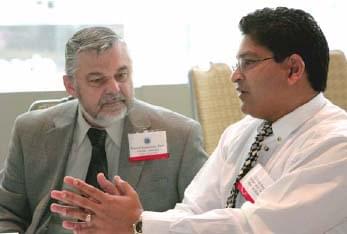
Dr Neil Singh, Medical Board of Trinidad and Tobago talks as
Dr. Fredrick, Saba University listens
-
The question, ‘what do we think is acceptable medical education?’ Different major points were made to determine what is driving this whole discussion — if we are talking about standards for the world or standards just for the United States. Medical educators believe that medical education should encompass certain minimal principles. The strengths and weaknesses of potential approaches were discussed.
. -
A deadline for rewrite was suggested. The five different sections within the standards were discussed and assigned:
-
Institutional
-
Programs for the MD Degree
-
The Medical Student - Jim and Andy
-
The Faculty - Shokat
-
Educational Resources – Victor
-
The Committee meeting was called to a close.

Bulgaria’s Representatives; Anna Ruski and Dr. Elena Piperkova

Tom Monahan, NY, Steve Seeling, JD, ECFMG Dr. Lynn Eckhert
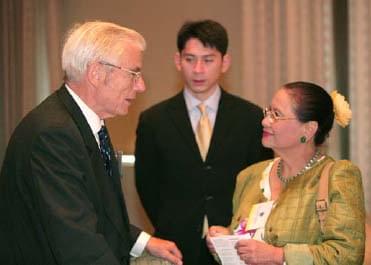
Drs. Jim Appleyard and Juliet Santos talk while her son listens
President Bernie Ferguson announced there had been some complaint that there was insufficient notice of this meeting to discuss standards. He read the communication from the United Kingdom’s General Medical Counsel to that effect and therefore extended the time for written comment to be certain everyone has the opportunity to provide his or her opinion and/or recommendations.